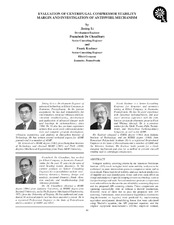| dc.description.abstract | Stringent stability screening criteria by the American Petroleum Institute (API) result in higher level rotor stability analyses to be performed on more intermediate-pressure compressor rotors and in more detail. These high-level stability analyses include predictions of impeller and seal rotordynamic forces and even extra effort on design and analysis of special damping devices as a backup, such as damper bearings and seals. Several moderate-pressure compressors were selected here to discuss the use of stability screening diagrams and the proposed API screening criteria. These compressors are operating successfully with or without a deswirl mechanism. However, most of them fail to pass the proposed new API screening. Furthermore, rotor aerodynamic logarithmic-decrements (log-decrements or log-dec) were predicted by implementing equivalent aerodynamic destabilizing forces that were calculated using Wachel’s equation, the API proposed equation, and the original equipment manufacturers (OEMs) empirical method, respectively. In practice, shunt injection and swirl-brakes are standard tools to enhance rotor stability if the predicted log-decrement is relatively low. When adopted with balance pistons or center seals, the swirl brakes are typically installed behind the impeller and outside the labyrinth seal. However, the deswirl effect of the swirl brake is sometimes limited due to its locations away from the entrance of the balance piston or center labyrinth seal. Meanwhile, the implantation of the swirl brake would change the flow pattern behind the final stage impeller backwall. A unique antiswirl brake device was developed to integrate with typical labyrinth seals for improving high-performance compressor stability. The effectiveness of the antiswirl brake mechanism was experimentally investigated when used with the labyrinth seals on a rotating test rig. The gas flow circumferential velocity was measured at the swirl-brake upstream and downstream locations. Test results show the labyrinth seal was converted into a damping device by reducing the preswirl velocity to zero or even negative. | en |


